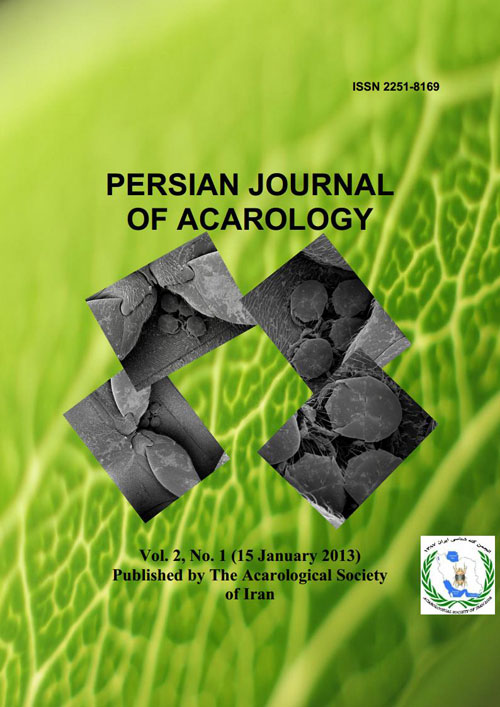فهرست مطالب

Persian Journal of Acarology
Volume:2 Issue: 1, Winter 2013
- تاریخ انتشار: 1391/11/28
- تعداد عناوین: 10
-
-
Page 1Zetomotrichus persicus sp. nov., a new species of oribatid mites (Acari: Oribatida) of the family Zetomotrichidae, is described from Iran. The new species is recognized by the anteromedial rostral denticulation; long and filiform sensilla with 13 relatively long barbs on outer and four on inner sides; broad and pennate notogastral seta c2; pyriform organ with two anterolateral tubes; and absence of adanal seta ad3. An identification key to the known species of Zetomotrichus is given.Keywords: Sisakht city, Kohkiluyeh va Boyer Ahmad province, Zetomotrichus, adult, key, mite
-
Page 9Four phytoseiid species, Amblyseius obtusus, Neoseiulus marginatus, N. sugonjaevi and N. zwoelferi were recorded and redescribed from alfalfa, Medicago sativa, in western Iran. Neoseiulus zwoelferi was determined as the abundant and widespread species in this region.Keywords: Predatory mite, Amblyseius obtusus, Neoseiulus marginatus, N. sugonjaevi, N. zwoelferi, biodiversity, Medicago sativa
-
Page 25A new oribatid mite species, Ramuselloppia vietnamica sp. nov. (Oppiidae), is described from soil of Southern Vietnam. The genus is recorded for the first time from Vietnam and the Oriental region. The morphology of the gnathosoma and legs of Ramuselloppia is presented in detail for the first time. An annotated checklist of oribatid mite taxa from a dipterocarp forest of Dong Nai Culture and Nature Reserve is presented. It includes 40 species, 29 genera and 19 families.Keywords: oribatid mites, new species, Ramuselloppia, Dong Nai Culture, Nature Reserve, Vietnam
-
Page 35Neotetranychus lek sp. nov., a spider mite collected in Thailand, is described and figured. A key to the world species of Neotetranychus, based on females, is presented.Keywords: mite, taxonomy, female, Trombidiformes, Acariformes
-
Page 49Aegyptobia pirii sp. nov. is described and illustrated based on female specimens collected from Bromus tectorum L. (Poaceae) in Tuyserkan, Hamedan province in Iran. A key to all known Iranian species of the genus is provided.Keywords: Trombidiformes, Prostigmata, key, mite, Tetranychoidea, Toyserkan, Iran
-
Page 57Larvae of Ralphaudyna iranensis Zhang & Saboori, 1995 are collected ectoparasitic on Lophopilio palpinalis (Herbst, 1799) (Arachnida: Opiliones, Phalangiidae) and from soil (off host) in a forest in Masooleh, Roodbar, Hashtpar, Rasht and Astara cities, Guilan province, Iran and also from grasshopper (Orthoptera: Acrididae) in Abbas Aabad region, Behshahr city, Mazandaran province, Iran. This paper presents new morphological data for R. iranensis.Keywords: Parasitengona, Trombidiformes, Prostigmata, Lophopilio palpinalis, ectoparasite, Iran
-
Page 63The present checklist provides the results of a survey of collected and identified mesostigmatic mites in Iran (excluding the family Phytoseiidae) including 348 species belonging to 128 genera, 39 families, and 17 superfamilies of which one genus (Trachyuropoda Berlese, 1888) is a new record for Iranian mite fauna. It is annotated with some corrections to specific identities which have previously reported by Iranian literature and with known geographical and habitats distributions inIran. Suborders Sejida and Trigynaspida comprise three and seven recorded species belonging to two and six genera, respectively, and Monogynaspida (except the Phytoseiidae) with 338 species belonging to 120 genera. No species of the cohorts Heatherellina and Heterozerconina has been recorded fromIran yet.Keywords: Checklist, Acari, Mesostigmata, Monogynaspida, Trigynaspida, Sejida, Iran
-
Page 159Iranian mites of the family Parasitidae were reviewed in the base of literature and collected materials were reviewed. Cornigamasus lunaris Berlese, Parasitus lunariphilus Makarova, P. mustelarum Oudemans and Vulgarogamasus kraepelini (Berlese) are reported for the first time from Iran. The specimens which had been cited previously as Parasitellus talparum (Oudemans) were re-examined and identified as P. fucorum (De Geer). Also, a key to Iranian genera of the family, distribution and habitats information of the Iranian species are presented.Keywords: Acari, Mesostigmata, Parasitidae, Parasitinae, Pergamasinae, Iran
-
Page 181Predation preference of Neoseiulus californicus (McGregor) and Typhlodromus bagdasarjani Wainstein & Arutunjan on Scolothrips longicornis Priesner and heterospecific phytoseiid was determined on cucumber leaf discs in presence and absence of Tetranychus urticae Koch. The experiments were conducted under laboratory conditions at 25˚C, 65% RH and a photoperiod of 16h light: 8h dark. The first and second instar of the thrips and larval stages of the phytoseiids were selected as intraguild preys. In the first experiment, the first or second instar larvae of the thrips and heterospecific larval phytoseiid (regarded as predator species) were offered to an adult female of phytoseiid. The females of N. californicus and T. bagdasarjani significantly preferred to prey upon the first instar larvae of the thrips (1.82 and 1.41 larvae per day, respectively) compared with phytoseiids (0.78 and 0.53 larva per day, respectively). Consumption of the two mentioned phytoseiid species on second instar larvae of the thrips (0.96 and 0.60 larva per day, respectively) and the phytoseiid (0.91 and 0.62 larva per day, respectively) were not significantly different. The females of both phytoseiid species were able to oviposit continuously when fed on the thrips and phytoseiid preys. In the second experiment, when T. urticae, the phytoseiid and thrips were offered simultaneously, both phytoseiid species could prey upon all three species but T. urticae was significantly consumed more (5.52 T. urticae per day by N. californicus and 4.46 T.urticae per day by T. bagdsarjani). Since these two predators belong to the type III phytoseiids, it seems that both species were able to survive in absence of T. urticae and tend to prey more on first instar larvae of the thrips compared with the heterospecific phytoseiid.Keywords: Neoseiulus californicus, Typhlodromus bagdasarjani, Scolothrips longicornis, predation preference, heterospecific phytoseiid

